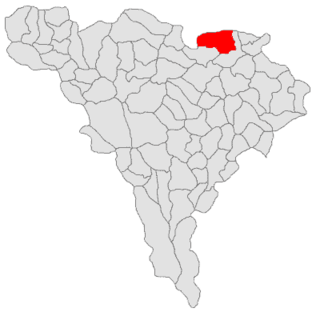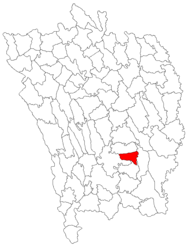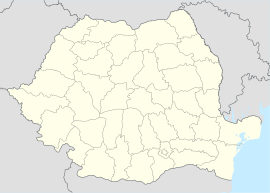
Vaslui County is a county (județ) of Romania, in the historical region Western Moldavia, with the seat at Vaslui.

The Krashovani are a South Slavic community inhabiting Carașova and Lupac in the Caraș-Severin County within Romanian Banat. They are regarded as and predominantly self-identify as Croats. They are Roman Catholic by faith and speak the Torlakian dialect. Glottolog lists "Karashevski" as sub-type of Croatian language.

Cârța is a commune in Romania, located in Harghita County. It lies in the Székely Land, an ethno-cultural region in eastern Transylvania. The commune is composed of two villages:

Dudeștii Vechi is a commune in Timiș County, Romania. Dudeștii Vechi is mostly populated by Banat Bulgarians (Palćene), a regional minority group of ethnic Bulgarians that profess Roman Catholicism, who came from northern Bulgaria, and who are descendants of Paulicians that settled in the area around 1738. At the 2011 census, the total population of the commune numbered 4203 people.

Atid is a commune in Harghita County, Romania. It lies in the Székely Land, an ethno-cultural region in eastern Transylvania.

A commune is the lowest level of administrative subdivision in Romania. There are 2,686 communes in Romania. The commune is the rural subdivision of a county. Urban areas, such as towns and cities within a county, are given the status of city or municipality.

Romania's administration is relatively centralized and administrative subdivisions are therefore fairly simplified.

Unirea, previously Vințu de Sus, is a commune located in the north-east of Alba County, Transylvania, Romania. It is composed of six villages: Ciugudu de Jos (Alfüged), Ciugudu de Sus (Felfüged), Dumbrava (Dombró), Inoc (Inakfalva), Măhăceni (Aranyosmohács) and Unirea.

Avrămești is a commune in Harghita County, Romania. It lies in the Székely Land, an ethno-cultural region in eastern Transylvania.

Ciucsângeorgiu is a commune in Harghita County, Romania. It lies in the Székely Land, an ethno-cultural region in eastern Transylvania.

Dealu is a commune in Harghita County, Romania. It lies in the Székely Land, an ethno-cultural region in eastern Transylvania. The commune is known for its plum-based pálinka and is composed of seven villages:

Plăieșii de Jos is a commune in Harghita County, Romania. It lies in the Székely Land, an ethno-cultural region in eastern Transylvania.

Săcel is a commune in Harghita County, Romania. It lies in the Székely Land, an ethno-cultural region in eastern Transylvania.

Șimonești is a commune in Harghita County, Romania. It lies in the Székely Land, an ethno-cultural region in eastern Transylvania.

Viișoara is a commune in Vaslui County, Western Moldavia, Romania. It is composed of four villages: Halta Dodești, Văleni, Viișoara and Viltotești. It included Dodești and Urdești villages until 2004, when these were split off to form Dodești Commune.

Vizantea-Livezi is a commune located in Vrancea County, Romania. It is composed of five villages: Livezile, Mesteacănu, Piscu Radului, Vizantea Mănăstirească and Vizantea Răzășească. It was formed in 1968 by merging the first three with the latter two.

Uivar is a commune in Timiș County, Romania. It is composed of four villages: Pustiniș (Öregfalu), Răuți (Aurélháza), Sânmartinu Maghiar (Magyarszentmárton) and Uivar. Two other villages, Otelec and Iohanisfeld, which had been part of Uivar commune since 1968, were detached in 2008 to form Otelec commune.

Olari is a commune in Prahova County, Muntenia, Romania. It is composed of three villages: Fânari, Olari and Olarii Vechi. Until 2004, these belonged to Gherghița Commune, when they were split off to form a separate commune.

Local elections were held in Romania on 5 June, 2016.
According to the Moldovan law on territorial administrative organisation, two or more villages can form together a commune.




















